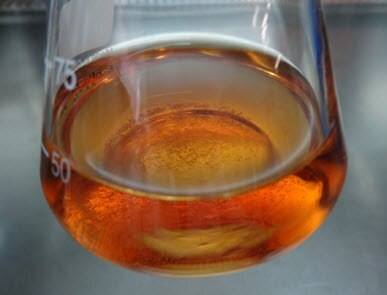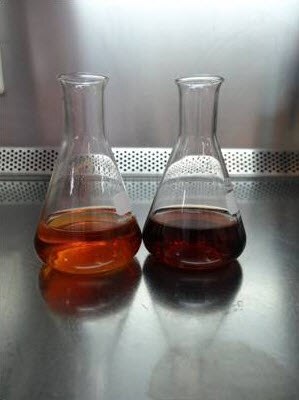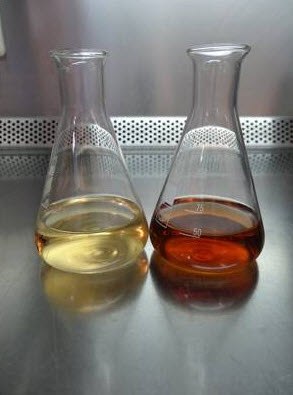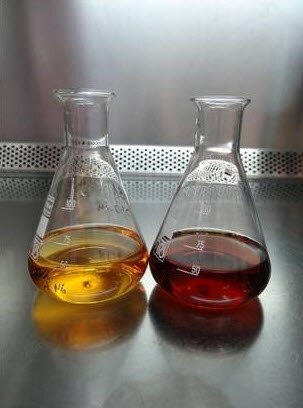EnPresso FAQs
Top Three Questions
General topics
E. coli cultures
P. pastoris cultures
Top Three Questions
Q. What are the most common reasons for lower than expected yield?
- Use of incorrect closures leads to poor oxygenation (DO NOT USE aluminum foil, or plastic lids)
- Overfilling of flask leads to poor oxygenation (maximum 10% fill volume in normal shake flasks)
- Use of aged starting culture
- Non-optimal shaker speed
- Incorrect culture time
- Foam production leads to poor oxygenation
Q. What is the medium supposed to look like?
A. EnPresso B growth system ready for use. Note small crystals of magnesium salts are visible – these do not affect performance.

Q. Do I need to autoclave the media?
A. No. EnPresso tablets are supplied pre-sterilized and added to sterile water. However, the media can be autoclaved if required. The resulting color change will not affect performance. The original liquid is on the left and the autoclaved liquid is on the right.

EnPresso™ B

EnPresso™ B Defined Nitrogen-free

EnPresso™ Y Defined
General topics
Q. Can I use EnPresso growth systems in fermenters?
A. Users have successfully transferred from shake flask to fermenter. However, to ensure a smooth transition, we recommend contacting our specialists who have an in-depth understanding of the parameters that may need to be adjusted for your specific expression system. If necessary, advice can be given after signing your CDA.
Q. Can I use the appropriate EnPresso growth system with my normal protocol for growth media?
A. No. It is ESSENTIAL to follow your EnPresso growth systems instructions exactly. They have been optimized to ensure optimal conditions for maximum yield. The value of following these instructions was recently confirmed by scientists at Vernalis, UK. Changing from M9 to EnPresso B Defined Nitrogen-free increased their yield by 13-fold. However, they were growing a 1L culture in a 2.5L baffled flask whereas instructions for use recommend using 10% of the flask volume as culture volume (20% if using an UltraYield flask). By reducing their culture volume, their yield was increased to 160 mg/L of EnPresso B Defined Nitrogen-free compared to 2.5 mg/L M9 – a 64-fold increase!
Q. How can I prevent foaming in my shake flask cultures?
A. We recommend the use of Antifoam 204 (final concentration of 100 µL/L), a solution with very high viscosity. This product has no negative effects on cell growth and can be autoclaved to ensure sterility.
Q. Are EnPresso growth systems for production of recombinant proteins compatible with subsequent purification systems?
A. Yes, protein expression in EnPresso growth systems can be used with virtually any purification tag. Wash the cell pellet before lysis. This step is essential for successful MBP-tag purification to remove excess polysaccharide and may improve product recovery for other tagged proteins. Spin down the cells. Discard the supernatant and resuspend the cells in 0.9% NaCl solution. Spin down again and repeat three times before proceeding with cell lysis/protein extraction.
Q. Does the glucose-releasing agent – Reagent A – need to remain on ice during inoculation or induction steps?
A. No. The product is very stable, but should be stored at 4-8 °C.
Q. What should I use to dilute the glucose-releasing agent – Reagent A – to facilitate a pipetting step?
A. Dilute with sterile water immediately before use. Do not store as a diluted solution.
Q. Can I use 96 deep-well plates?
A. Cultures grown in 96 deep-well plates can be very challenging as oxygenation is very poor in this format. We would recommend the use of 24 deepwell plates whenever possible.
Q. Are there chelating agents such as EDTA in EnPresso growth systems that could interfere with subsequent purification methods?
A. EDTA is present only in trace amounts in EnPresso growth systems and should not interfere with purification methods.
E. coli cultures
Q. Why is controlling glucose availability beneficial in an E. coli protein expression culture?
A. When E. coli grows under non-limiting conditions, i.e. glucose and other nutrients are present in excess, their growth is exponential and consequently the culture soon runs into oxygen limitation conditions. High glucose concentration also causes ‘overflow metabolism’, resulting in an accumulation of acetate. Both oxygen limitation and acetate accumulation will limit growth to relatively low cell densities (usually less than OD 10) and reduce the capacity of the cells to produce recombinant protein. In addition, exponential growth is coupled with very fast synthesis of the recombinant product, often exceeding the capacity of the cell’s folding machinery and results in product aggregation. EnPresso growth systems avoid these problems by controlling glucose availability and, in turn, the growth rate. Cells grow at a linear rate to much higher densities than in conventional media and the slower rate of protein synthesis facilitates production of proteins in an active, correctly-folded, soluble state. The result is an increased yield of functional protein.
Q. Why is adequate oxygen aeration so important in shake flasks?
A. Regardless of the growth system or media, cells can easily run into oxygen-limited conditions in conventional shake flasks. For example, oxygen starts to become limiting after as little as 4 hours after induction of an OD600 0.5 culture. The cellular response to oxygen limitation includes induction of more than 200 genes. The production of recombinant proteins is strongly impaired by lack of oxygen.
Q. Some shake flask manufacturers suggest using culture volumes up to 40%. Why do you recommend 10% for conventional flasks and up to 20% with Ultra Yield flasks?
A. E. coli is a very respiratory-active microorganism hence the fill volume should not exceed 10 % of the total volume of a conventional flask or 20% of an Ultra Yield flask to facilitate adequate aeration.
Q. Is there an advantage to using baffled shake flasks?
A. Baffled flasks are used to improve the oxygen transfer rate and so help to maintain good growth conditions. Although it is possible that the yield of a specific recombinant protein may be improved by use of a baffled flask, we have no evidence to suggest that this applies to all recombinant proteins produced in E. coli using EnPresso growth systems. Cultures grown in EnPresso growth systems reach higher cell densities when compared to cultures grown in conventional LB or TB media. However, there is no indication that these cultures are reaching a state of oxygen limitation.
Q. What are the key factors to consider in relation to shake flasks when producing recombinant proteins in bacteria?
A. Adequate control of nutrition and pH: provided by EnPresso growth systems Adequate aeration
- To provide good oxygen transfer the culture volume should be no more than 10% of the shake flask volume (20% if using Ultra Yield shake flasks)
- Use a standard shake flask such as an Erlenmeyer or a baffled Erlenmeyer. If a baffled flask is used, ensure that the flask closure does not get wet. Breathable membrane covers are ideal closures for all flask types, and the wetting in baffled flasks can be avoided by using an AirOtop Enhanced Seal.
Ensure that the majority of cells in the inoculum are in exponential growth phase
Protocols contain recommendations for optimal amplitude and shaking speed for commonly-used E. coli strains in Erlenmeyer and Ultra Yield shake flasks. Other strains or shake flasks may benefit from adjustment of the glucose-releasing agent – Reagent A. We recommend testing with 20%, 50%, 100% and 300% of the recommended concentration. The better the oxygenation and the higher the specific growth rate of the strain, the higher the enzyme concentration required for optimal results.
Q. Are there any protein types that may require changes to the standard protocol?
A. Current data indicates that membrane proteins give more variable yields and proteins normally secreted into the periplasm may be distributed differently between the cytoplasmic, periplasmic and extracellular spaces. For a small number of proteins we have seen a slight increase in yield by omitting the addition of the booster tablet. With toxic proteins, the harvest time should be optimized.
Q. Is the use of an EnPresso B growth system restricted to specific strains?
A. Currently, EnPresso B products contain protocols optimized for growth of the most commonly used E. coli strains. However, this does not limit their use to these strains. Tips for growing alternative strains are included in this support section and your application specialist will be happy to advise you. Note that if bacteria are designed to secrete proteases into the medium, this could interfere with the glucose feed. E. coli strains that require supplements, such as specific amino acids, may not grow well unless the required supplement is added.
Q. What induction methods are compatible with EnPresso growth systems for recombinant protein expression in bacteria?
A. EnPresso growth systems have been optimized for use with the most commonly-used inducer, IPTG. The slow glucose release in EnPresso growth systems does not prevent the intake of sugars such as lactose or arabinose when used as inducers. We recommend testing sugars at 10%, 50% and 100% concentrations of the standard dose. We are happy to hear from scientists who have used alternative inducers.
Q. Can I use my standard pre-culture method to inoculate an EnPresso culture? I would like to prepare the pre-culture in the same way as I do with LB cultures: growing overnight at 37 °C.
A. No. We strongly recommend using an actively growing culture for inoculation. An inoculum containing a large proportion of cells in the exponential growth phase is an essential requirement for a successful culture. Overnight cultures contain mainly cells in the stationary phase. With only a small number of dividing cells, glucose may accumulate resulting in very poor growth. A poor quality inoculant may also risk the transfer of growth retarding components into your EnPresso culture.
Q. Can I use cells directly from my glycerol stock as an inoculum for the main EnPresso culture?
A. If your glycerol stock has a high cell density such as OD600=20, it could be used for general protein expression. However, if you are working with process development the transfer of glycerol to the main culture would provide an additional carbon source for the cells resulting in a prolonged batch phase - the most extreme case would mean that the cells will not reach glucose-limited conditions before induction.
Q. Why do you recommend 30 °C for bacterial cultures? Can I use lower or higher temperatures?
A. Lower temperatures have been used in the past in order to slow down growth rate and thereby improve solubility of the final product. EnPresso growth systems control growth rate and metabolism (including protein expression) by balancing the supply of nutrients. This approach avoids stressing cells at lower temperatures thereby minimizing the risk of protein aggregation or degradation. Should you still wish to use a lower temperature, you will need to optimize the concentration of glucose-releasing agent – Reagent A. EnPresso growth systems perform well at cultivation temperatures between 15 to 42 °C.
Q. Your instructions are optimized for E. coli BL21 and their derivative strains, but I am growing other strains. What parameters can be adjusted to achieve a higher biomass?
A. We recommend 1.5 U/L initial dose and 1.5 U/L dose of Reagent A at the point of induction (boosting) for all E. coli strains. These doses are optimal, but in well-aerated systems production may be enhanced by higher dosing during boosting. If using conventional Erlenmeyer flasks optimization of shaking conditions may also improve results. Refer to the instructions for use supplied.
Q. Why do we see some exponential cell growth after inoculation?
A. At the beginning glucose consumption rate is smaller than the volumetric glucose release rate and only a small number of cells can consume glucose and therefore their growth rate is higher. When the culture reaches the linear growth phase glucose consumption rate and volumetric glucose release rate are in balance.
Q. I am unable to achieve the required minimum OD600 of 0.15 in my multiwall plates. I cannot add a defined cell number from pre-cultures to each well. What can I do?
A. Start by adding only cells and antibiotics to the EnPresso growth system. Wait 1.5 hours before adding the glucose-releasing agent – Reagent A.
Q. I am using slow-growing cells (a strain with two plasmids and another with several mutations). I cannot get sufficient cells from the pre-culture to start with an O.D. = 0.1 in the EnPresso culture. What can I do?
A1. Prepare the inoculum using an overnight culture on an antibiotic plate as follows:
Suspend a single bacterial colony in 50 µL LB or 0.9 % NaCl.
Apply the cell suspension onto the antibiotic plate (e.g. LB agar plate containing 2 g/L glucose and 100 mg/L ampicillin) and spread immediately all over the plate.
Cultivate the plate overnight (preferably at 30 oC).
Harvest the bacterial culture next morning by applying 2 mL 0.9 % NaCl onto the plate and detaching the bacteria from the surface with an L-shaped spreader. Collect the liquid, measure the cell density and add the required volume of inoculum to the EnPresso culture to reach OD=0.1.
Q. How can I get enough cells for inoculation when I need to work with more than 50 mL of culture volume?”
A1. If working with a 100 mL volume, inoculate two tubes with each 2 mL LB medium containing antibiotics. Incubate at 37 °C for 6-8 hours with vigorous shaking. Combine both pre-cultures for inoculation of the main culture. Follow the standard protocol.
A2. If working with more than 100 mL volume, follow one of the protocols described above for slowly growing cells.
Q. How can I improve the production efficiency (yield) of a very toxic recombinant protein expressed in E. coli?
A. If the recommended protocol does not enable you to achieve sufficient yield, we recommend that you delay the induction time to enable cells to grow to a higher biomass before induction. The more toxic protein, the better it is to wait as long as possible prior to induction in order to maximize the cell density and therefore the production efficiency. When using EnPresso B it may be advantageous to add the booster tablet earlier than recommended in the standard protocol to achieve a higher cell mass before induction. Induction times with toxic proteins are typically considerably shorter than in standard protocols. We recommend harvesting samples at 2h, 4h and 6h after induction to identify the optimal harvest time. To ensure that the expressing cells have sufficient glucose, we recommend using higher Reagent A doses (up to 10 U/L) at the point of induction.
Q. How can I improve results when working with a slow-growing bacterial strain?
A. EnPresso product protocols have been developed to give optimal performance for the most commonly used strains and expression systems. In-house experiments have indicated that slow-growing strains may benefit by reducing the amount of glucose-releasing agent, Reagent A, by 50%. This prevents the accumulation of excess glucose which can lead to anaerobic conditions and a reduction in pH.
Q. I want to grow an auxotrophic strain of E. coli. How can I ensure good results?
A. To grow auxotrophic strains of E. coli that are deficient in, for example, thymine, methionine, or arginine, the additional amino acids or substrates required by the auxotroph must be added to EnPresso B to ensure efficient growth.
Q. In our shaker the so-called “diameter orbit” is 1.9 cm. Does it mean the same as the amplitude? And how can this influence the results?
A. The diameter orbit is the same as amplitude. We have seen some limitations when using 50 mm amplitude due to lower oxygenation. Since 1.9 cm is close to 2.5 cm, follow the standard protocol. If pH drops to below 6.5 (a sign of glucose accumulation), reduce the concentration of Reagent A by 50%.
Q. Our shakers can only be set to a maximum of 200 rpm. Will the protocol work with a lower shaking speed?
A. The diameter orbit is the same as amplitude. For 1.9 cm amplitude we recommend 300 rpm shaking speed to compensate for the lower shaking efficiency. If 300 rpm is not possible or pH drops below 6.5 (a sign of glucose accumulation) the Reagent A concentration should be reduced by 50%.
Note: 50 mm amplitude provides much better aeration and consequently somewhat slower shaking can be used (e.g. 200 rpm instead of 250 rpm). Lowering the shaker speed is justified only to avoid spillage.
Note: 50 mm amplitude cannot be used with Ultra Yield Flasks because the mixing is so efficient that next morning you may find your growth media on the incubator walls.
P. pastoris cultures
Q. Is the use of an EnPresso Y Defined growth system restricted to a specific expression host?
A. Currently, the EnPresso Y Defined protocol has been optimized for growth of Pichia pastoris. However, this does not limit its use to this host and work is ongoing to develop protocols for other yeasts.
Q. What induction methods are compatible with EnPresso growth systems for recombinant protein expression in yeast?
A. EnPresso Y Defined is compatible with AOX promoters that use methanol induction. Although we currently have no examples, EnPresso growth systems for yeast should be compatible with metabolizable inducers such as ethanol and fatty acids. The slow release of glucose should not prevent this type of induction.
Q. Does glucose released in the EnPresso Y Defined growth system affect methanol induction when using AOX1 or AOX2 promoters in yeast?
A. No
Q. What are the key factors to consider in relation to shake flasks when producing recombinant proteins in yeast?
A. The protocol supplied with EnPresso Y Defined kits is optimized for use with Pichia pastoris, using an AOX promoter.
Adequate control of nutrition and pH: provided by EnPresso Y Defined growth system
Adequate aeration
To provide good oxygen transfer the culture volume should be no more than 10% of the shake flask volume (20% if using Ultra Yield shake flasks)
Use a standard non-baffled shake flask to avoid wetting of the closure and close the flask with a breathable membrane cover. We recommend and supply UltraYield Shake Flasks with AirOtop Seals.
Ensure that the majority of cells in the inoculum are in exponential growth phase
Protocols contain recommendations for optimal amplitude and shaking speed in Erlenmeyer and Ultra Yield shake flasks.
Q. Why is adequate oxygen aeration so important in shake flasks?
A. Regardless of the growth system or media, cells can easily run into oxygen-limited conditions in conventional shake flasks impairing growth and therefore reducing biomass
Q. How can I monitor pH changes in a yeast culture?
A. Values above pH 7.6 are indicative of severe carbon-starvation and excess use of the nitrogen-containing organic compounds as a carbon source – leading to the release of ammonia and elevated pH.
To detect an increase above pH 7.6, use bromothymol blue, a non-toxic pH indicator, at a final concentration of 1-3 mg/L. The culture will become blue when the pH exceeds pH 7.6. Lower the pH by adding 5N HCl until the blue color disappears.
Q. Your instructions are optimized for Pichia pastoris, but I am growing another strain and having a problem with pH control. What parameters can be adjusted?
A. Adding additional glucose-releasing agent, Reagent A, can increase the amount of glucose and thereby reduce pH. Conversely using less Reagent A will help to increase pH
To continue reading please sign in or create an account.
Don't Have An Account?